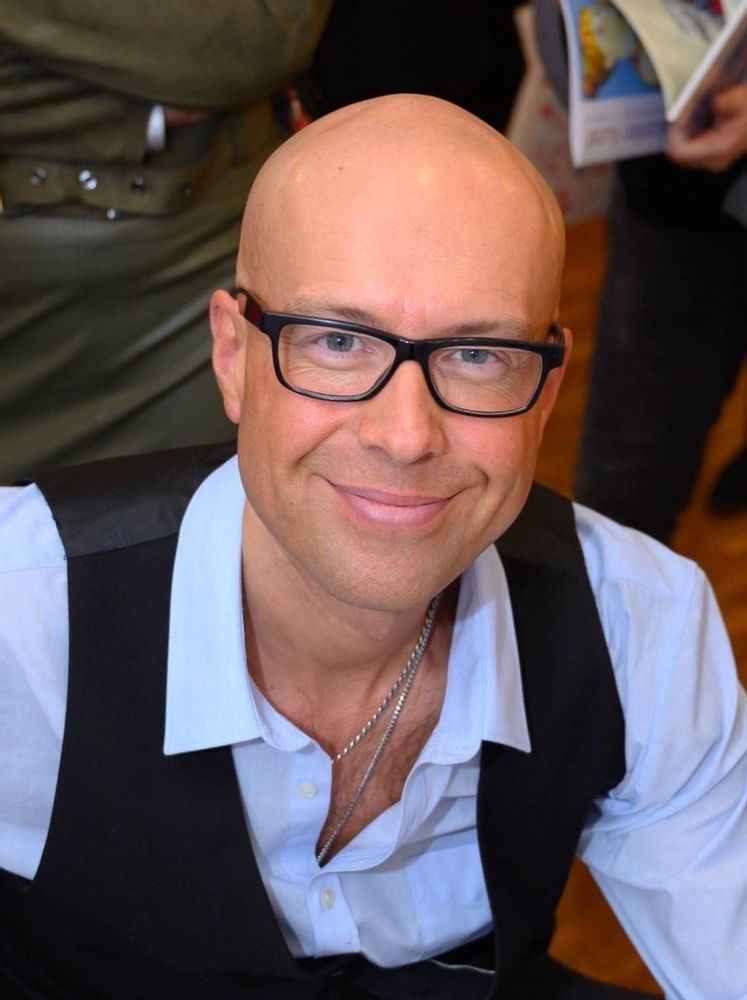
Christian Hoeld-Kris Katta
Accade di frequente nel percorso degli artisti di effettuare modifiche stilistiche anche radicali a seguito delle quali possono addirittura giungere a non riconoscersi più nell’espressività precedente; in altri casi invece la necessità di cercare il proprio personale linguaggio, che può impiegare anche diverso tempo prima di manifestarsi, si esprime con una sperimentazione costante che induce l’artista a misurarsi per la maggior parte del suo cammino con differenti e variegate forme stilistiche. Nel caso di Christian Hoeld invece il dualismo diviene un dialogo tra due sue personalità creative, quella più vicina a un Cubismo nuovo, inedito, affascinante e orientato a osservare la realtà da diverse sfaccettature, e quella di Kris Katta, suo alter ego, più irruento, più libero da ogni schema pittorico, meno attento alle regole e incline a seguire il puro impulso creativo, che invece è decisamente inquadrabile nell’Espressionismo Astratto. Le due identità pittoriche di Christian Hoeld dialogano tra loro, o meglio sono una l’estensione dell’altra, un completamento necessario per definire la sua eclettica indole artistica che da un lato sente il bisogno e il desiderio di effettuare quell’analisi scientifica dell’osservazione della realtà legata alla tematica cubista, quell’esigenza di frammentare ciò che viene osservato per poi ricomporlo attraverso la bidimensionalità necessaria per esplorare, indagare e spiegare le molteplici sfaccettature dei soggetti o dei concetti espressi; dall’alto lato, al contrario, la creazione di Kris Katta permette all’artista di liberare la sua parte più istintiva, quella che non vuole attenersi a un processo creativo definito bensì lascia fuoriuscire le sensazioni percepite senza alcun contatto con la razionalità, senza la consapevolezza che le renderebbe analizzabili dalla logica. Subito dopo la fase dell’impulso, Katta introduce la fotografia digitale, immagini rielaborate che costituiscono un’ulteriore esplorazione della realtà raffigurata, infondendo alle sue opere quel bilanciamento tra reale e immaginato, tra emozione e consapevolezza, tra impeto espressivo e desiderio di mettere ordine e dare un senso al percepito. La scelta di assumere un nome d’arte che possa distinguere i suoi due mondi espressivi denota la volontà di Hoeld di lasciar convivere entrambe le sue personalità in maniera distinta, separata l’una dall’altra, come se fosse indispensabile la coesistenza alla pari, senza che l’uno assorba l’altro o prevalga. Ciò che accumuna entrambe le identità pittoriche è la tendenza all’inesplicato, al non voler dare all’osservatore un messaggio chiaro e subito comprensibile, perché ciò che importa e che affascina in un’opera d’arte è anche quel sottile mistero, quella spinta a cercare il significato profondo che si nasconde dietro la figurazione o la non forma; sembra un’esortazione ad andare oltre quella di Hoeld-Katta, una spinta all’esplorazione di ciò che appare lasciandosi trasportare dalle sensazioni profonde che suscita ma anche dagli interrogativi che emergono dall’immagine, come se in fondo la bellezza e l’emozione si nascondessero proprio nella tendenza a spiegare ciò che è celato, che risulta ermetico e che si manifesta solo dopo una profonda riflessione. Nell’opera Die Liegende (L’orizzontale)

Die Ligende (la sdraiata) – Christian Hoeld
solo a un secondo sguardo emerge la consapevolezza di trovarsi davanti a un nudo di donna perché a primo impatto ciò che colpisce è il volto scomposto eppure intenso, ripiegato in se stesso e tuttavia fiero, come a voler esprimere la naturalezza della posa e del corpo senza veli. Dunque significati celati nel Cubismo tanto quanto nell’Espressionismo Astratto di cui il dipinto Untitled (Senza titolo)
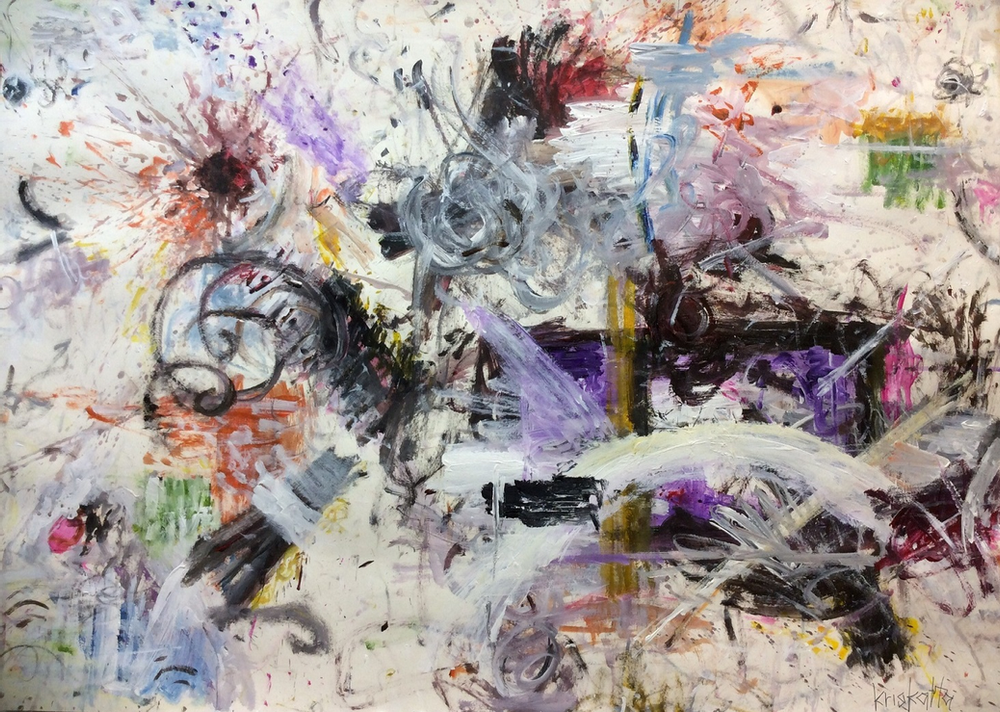
Untitled (Senza titolo) – Kris Katta
è un simbolo; in quest’opera le emozioni di Kris Katta esplodono letteralmente riversandosi sulla tela ma poi altri pensieri emergono, raccontati attraverso l’intervento sul colore avvenuto in un secondo tempo e attraverso il quale il processo mentale fluisce rapido e inarginabile creando una connessione con il fruitore dell’opera che si sente coinvolto a livello istintivo. Andiamo ora a conoscere più approfonditamente questo eclettico artista.
Lei ha scelto, come Christian Hoeld, uno stile decisamente particolare e anche fuori dal comune nell’era contemporanea: è un’inclinazione naturale la sua oppure è l’evoluzione di un percorso pittorico ad averla condotta al Cubismo?
Penso che si tratti di entrambe le cose. Da un lato c’è un amore per lo stile e dall’altro il risultato di un’evoluzione artistica verso il Cubismo che per me è una forma d’arte senza tempo poiché mi sono reso conto di poter trovare approcci costruttivisti in tutto ciò che incontro quotidianamente. Che sia nel volto di una persona, in una bottiglia, in una casa, in un telefono cellulare o anche in un computer. Tutte le forme della vita quotidiana hanno elementi cubisti, bisogna solo inserirli in un contesto con la superficie e lo spazio. Il Cubismo permette una rappresentazione da diverse prospettive e offre anche una visione dell’essenza delle cose del mondo per mezzo di una visione trascendentale, cioè una visione oltre la superficie.
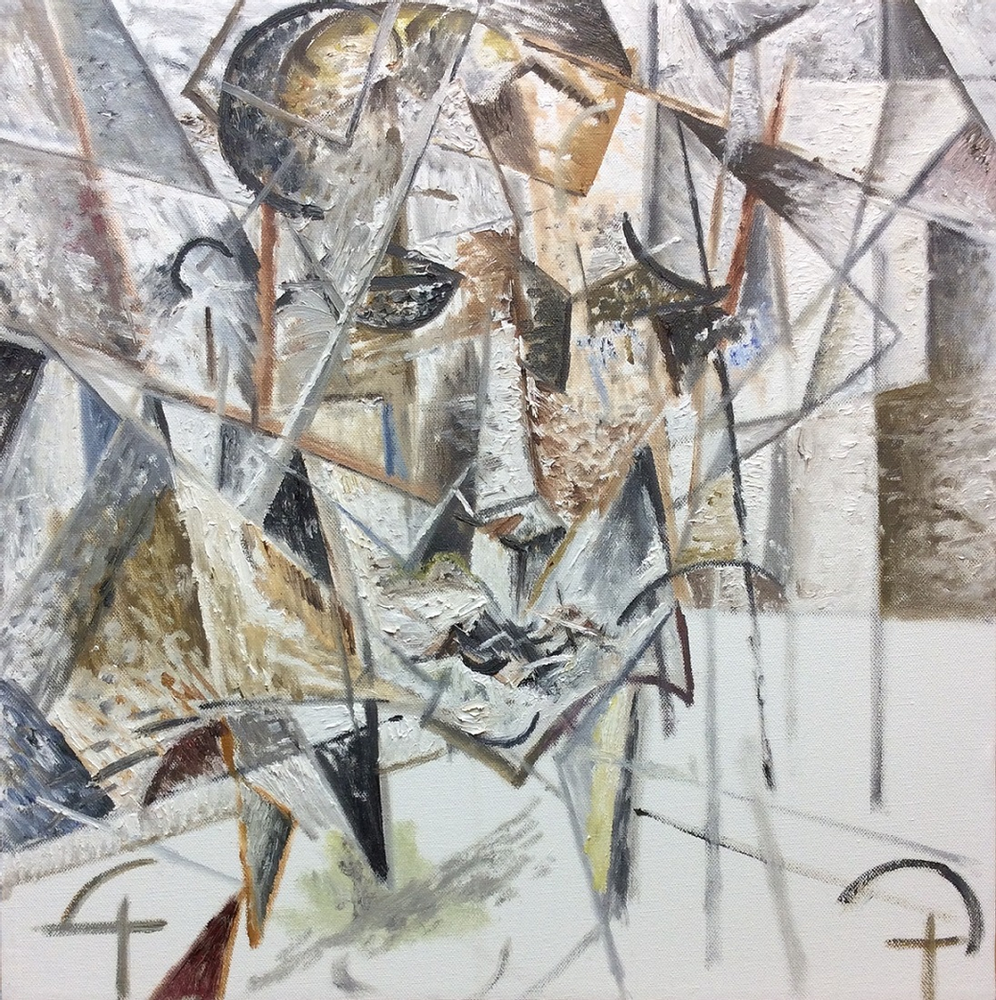
Bildnis eines Madchen (immagine di ragazza) – Christian Hoeld
Come Kris Katta invece si è avvicinato all’Espressionismo Astratto, come riesce a conciliare queste due modalità espressive apparentemente tanto discostanti tra loro? Ne esiste una più predominante sull’altra?
La pittura cubista offre la possibilità di sperimentare, come anche l’Espressionismo astratto.
Cercavo altre possibilità espressive oltre il Cubismo Analitico, che per me rappresenta un punto alto del modernismo classico e dell’avanguardia, oltrepassando questo stile apparentemente così rigido e ridotto a un linguaggio visivo schematico per continuare in direzioni diverse, per modificarmi e reinventarmi. Sono così andato ancora più lontano nell’astrazione e ho ampliato la tavolozza dei colori con forme e segni simbolici. Höld è un pittore che tende a condensare e ad un certo punto ho voluto guadagnare più libertà, perché dopo tutti gli anni di pratica del cubismo, ho sentito un forte impulso ad offrire più spazio all’intuizione e a sfumare il più possibile i processi cognitivi, dunque era necessario qualcosa di più radicale, un esperimento con il colore, la forma, la riduzione e i nuovi media. È così che sono arrivato a questo stile più libero e selvaggio che mi ha conquistato fin dall’inizio, da quel momento è nato Kris Katta. Höld rappresenta il Cubismo e il suo ulteriore sviluppo ed è il mio fondamento. Katta è ancora più libertà e trasformazione. Uno è un complemento dell’altro e viceversa.
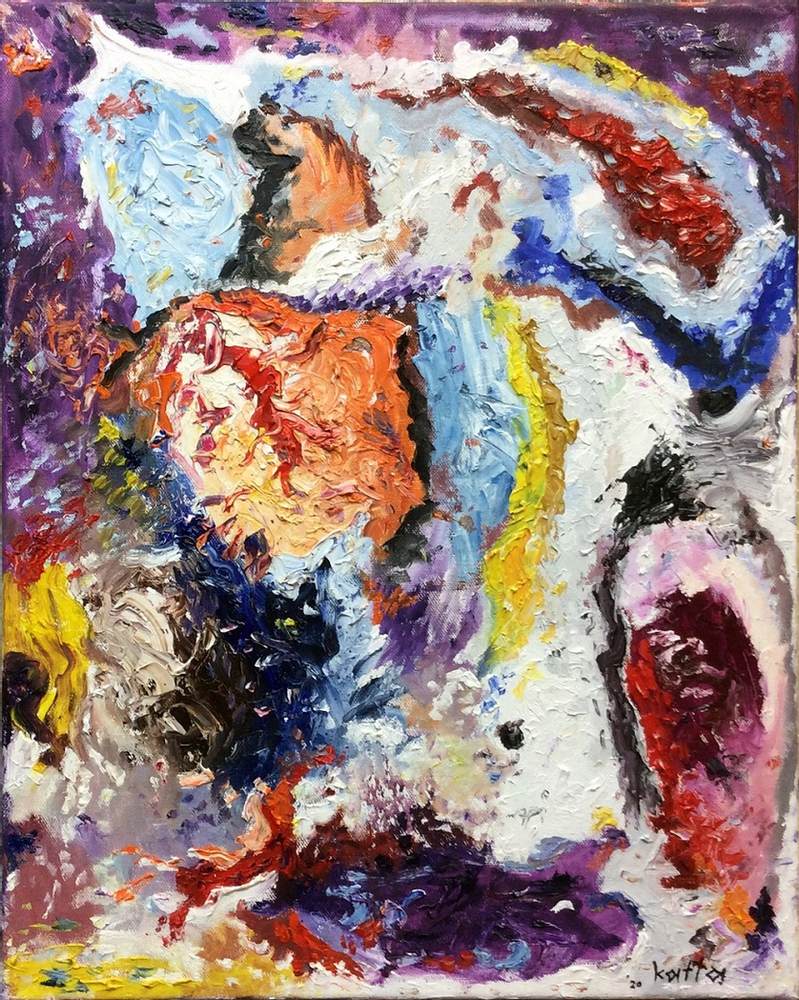
Die Windsbrout (La sposa del vento) – Kris Katta
La sua personalità artistica presenta una parte più riflessiva e razionale e un’altra più impulsiva; quanto è importante la coesistenza di entrambe e quanto l’una alimenta l’altra?
L’esistenza di entrambe le parti è molto importante. La pittura o l’arte in generale è sempre riflessiva, razionale ma anche impulsiva. Solo alcune cose accadono nel subconscio e non sono poi così facilmente riconoscibili. Penso che il lavoro di Katta sia inconsciamente influenzato dall’esperienza, dalle preferenze e dall’abilità di Höld. È lo stesso al contrario perché non si può spegnere completamente il cervello. La trasformazione è un punto importante e probabilmente la chiave! Il quadro esige qualcosa da me, mi sfida. Con Höld ci sono più processi pensati e razionali mentre con Katta la realizzazione dell’opera è più veloce e impulsiva con la possibilità di non voler o poter controllare tutto.
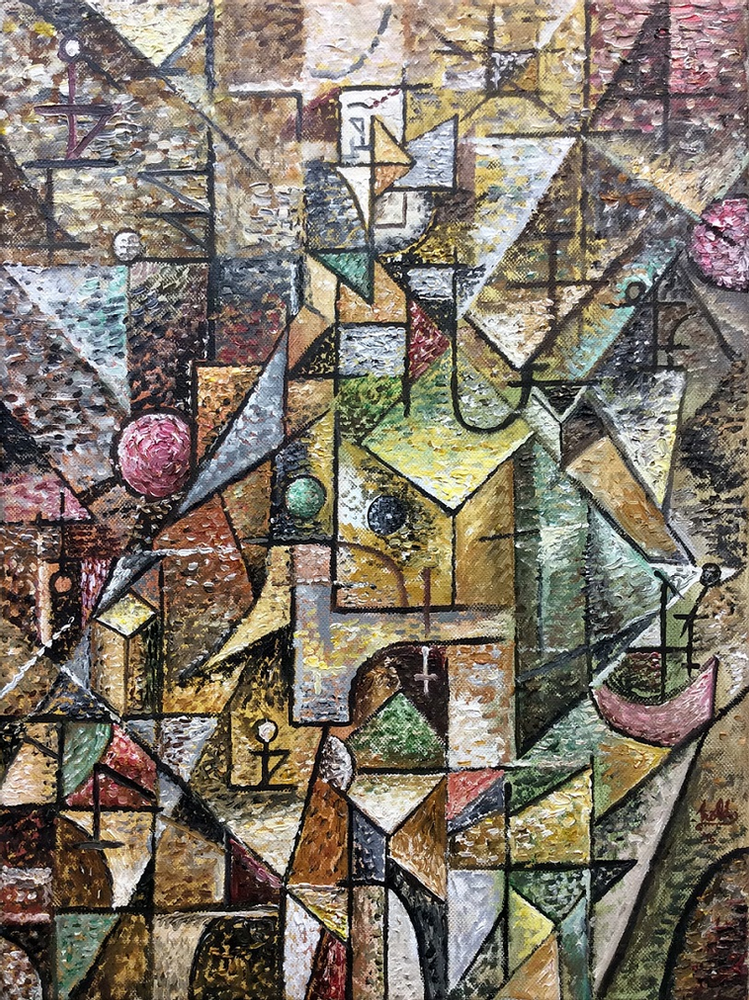
Frau (Signora) – Christian Hoeld
Qual è stato il momento in cui ha sentito che l’arte sarebbe stata la sua strada e quando invece si è manifestata questa ambivalenza pittorica? C’è stato un episodio scatenante che ha determinato la nascita di Kris Katta?
Ho sempre saputo che la pittura sarebbe stata la mia strada. Sono passato attraverso molte cose e ho studiato il Modernismo Classico, le sue tappe, i suoi stili e le sue possibilità espressive basate su un intenso legame con la natura. Per me, la capacità di rappresentare la natura è la base di un artista. Tutto il resto può poi essere costruito e sviluppato. La causa scatenante della nascita di Kris Katta è stato il desiderio di una forma di espressione più libera unita alla volontà di impegnarmi realizzandola e di esplorarla in forma sperimentale. È stato un processo, di ripensamento e di trasformazione. Quando ho capito che potevo essere entrambi è stato un enorme arricchimento per me. Ora posso vivere i miei due diversi lati e con il medesimo impegno e la stessa passione. La mia aspirazione in entrambi gli stili è di creare una pittura espressiva e misteriosa.
Ci racconta quali sono i suoi prossimi progetti? Prevede di esporre prevalentemente Hoeld o Katta, oppure entrambi nella stessa misura?
In effetti, ho alcune idee e progetti per il futuro e farò tutto il possibile per presentare il mio lavoro a un pubblico più ampio. Sto pianificando delle mostre: a novembre parteciperò per la prima volta ad Art Brussells. Ho intenzione di integrare la fotografia digitale nella pittura di Katta e sono molto impegnato nello sviluppo di questa idea di cui ho già prodotto le prime opere. Posso ben immaginare che in futuro ci sarà una mostra in cui saranno accostate le opere di Katta e Hoeld. Per quanto riguarda il continuare ad esporre, non voglio privilegiare nessuna delle mie identità di artista.
CHRISTIAN HOELD-CONTATTI
Email: ch@art-hoeld.at
Sito web: www.art-hoeld.at
Facebook: https://www.facebook.com/profile.php?id=100014996866896
Instagram: https://www.instagram.com/christianhoeld/
Marta Lock’s interviews:
Christian Hoeld, an artist’s surprising double identity
Artists often make stylistic changes, even radical ones, as a result of which they may no longer recognise themselves in their previous expressions. In other cases, however, the need to search for their own personal language, which may take some time to manifest itself, is expressed through constant experimentation that leads the artist to measure himself for most of his career with different and varied stylistic forms. In the case of Christian Hoeld, on the other hand, dualism becomes a dialogue between two of his creative personalities: the one closer to a new, unprecedented and fascinating Cubism, oriented towards observing reality from different facets, and the one of Kris Katta, his alter ego, who is more impetuous, freer from all pictorial schemes, less attentive to rules and inclined to follow the pure creative impulse, which instead can be decisively framed within Abstract Expressionism. Christian Hoeld’s two pictorial identities dialogue with each other, or rather they are an extension of each other, a necessary complement to define his eclectic artistic nature which, on the one hand, feels the need and desire to carry out that scientific analysis of the observation of reality linked to the Cubist theme, that need to fragment what is observed and then recompose it through the two-dimensionality necessary to explore, investigate and explain the multiple facets of the subjects or concepts expressed; on the other hand, on the contrary, Kris Katta’s creation allows the artist to free his most instinctive side, the one that does not want to follow a defined creative process but lets perceived sensations escape without any contact with rationality, without the awareness that would make them analysable by logic. Immediately after the impulse phase, Katta introduces digital photography, reworked images that constitute a further exploration of the reality depicted, infusing his works with that balance between the real and the imagined, between emotion and awareness, between expressive impetus and the desire to put order and make sense of what is perceived. The decision to adopt a stage name that distinguishes his two expressive worlds denotes Hoeld’s desire to allow both his personalities to coexist separately, as if it were essential for them to coexist as equals, without one absorbing the other or prevailing. What both pictorial identities have in common is a tendency towards the inexplicable, towards not wanting to give the observer a clear and immediately comprehensible message, because what is important and what fascinates in an artwork is also that subtle mystery, that drive to seek the profound meaning hidden behind figuration or non-form; Hoeld-Katta’s artwork seems to be an exhortation to go beyond, a push to explore what appears, letting oneself be carried away by the profound sensations that it arouses, but also by the questions that emerge from the image, as if beauty and emotion were covert in the tendency to explain what is hidden, what is hermetic and only becomes apparent after deep reflection. In the artwork Die Liegende (The Horizontal), only a second glance reveals the awareness that one is in front of a nude woman, because at first glance what strikes one is the face, dishevelled yet intense, folded in on itself and yet proud, as if to express the naturalness of the pose and the body without veils. Hence, meanings hidden in Cubism as much as in Abstract Expressionism, of which the Untitled painting is a symbol; in this work, Kris Katta’s emotions literally explode, spilling out onto the canvas, but then other thoughts emerge, recounted through the intervention on the colour carried out later, through which the mental process flows rapidly and unarginably, creating a connection with the viewer who feels instinctively involved. Let us now get to know this eclectic artist in detail.
Like Christian Hoeld, you have chosen a style that is decidedly particular and also out of the ordinary in the contemporary era: is this a natural inclination or is it the evolution of a pictorial path that led you to Cubism?
I think it is both. On the one hand there is a love for the style and on the other hand the result of an artistic evolution towards Cubism, which for me is a timeless art form as I realised that I can find constructivist approaches in everything I encounter on a daily basis. Be it in a person’s face, in a bottle, in a house, in a mobile phone or even in a computer. All forms of everyday life have Cubist elements, you just have to put them in context with surface and space. Cubism allows representation from different perspectives and also offers a view of the essence of things in the world by means of transcendental vision, namely a vision beyond the surface.
Like Kris Katta, you approached Abstract Expressionism, how do you reconcile these two apparently very different modes of expression? Is one more predominant than the other?
Cubist painting offers the possibility to experiment, as does Abstract Expressionism.
I was looking for other expressive possibilities beyond Analytical Cubism, which for me represents a high point of Classical Modernism and the avant-garde, going beyond this style that is apparently so rigid and reduced to a schematic visual language to continue in different directions, to modify and reinvent myself. So I went even further into abstraction and expanded the colour palette with symbolic shapes and signs. Höld is a painter who tends to condense and at a certain point I wanted to gain more freedom, because after all the years of practising Cubism, I felt a strong urge to offer more space for intuition and to blur the cognitive processes as much as possible, so something more radical was needed, an experiment with colour, form, reduction and new media. That’s how I arrived at this freer, wilder style that won me over from the start, and from that moment Kris Katta was born. Höld represents Cubism and its further development and is my foundation. Katta is even more freedom and transformation. One is a complement to the other and vice versa.
Your artistic personality has a more reflective and rational side and a more impulsive side; how important is the coexistence of both and how much does one feed the other?
The existence of both sides is very important. Painting or art in general is always reflective, rational but also impulsive. Only some things happen subconsciously and are not so easily recognisable. I think Katta’s work is subconsciously influenced by Höld’s experience, preferences and skill. It’s the same in reverse because you can’t completely switch off the brain. Transformation is an important point and probably the key! The painting demands something from me, it challenges me. With Höld, there are more thoughtful and rational processes, whereas with Katta, the realisation of the artwork is faster and more impulsive, with the possibility of not wanting or being able to control everything.
Which was the moment when you felt that art would be your path and when did this pictorial ambivalence manifest itself? Was there a trigger that led to the birth of Kris Katta?
I always knew that painting would be my path. I went through many things and studied Classical Modernism, its stages, styles and expressive possibilities based on an intense connection with nature. For me, the ability to represent nature is the basis of an artist. Everything else can then be built upon and developed. The trigger for the birth of Kris Katta was a desire for a freer form of expression coupled with a willingness to engage with it and explore it in an experimental form. It was a process of rethinking and transformation. When I realised that I could be both, it was a huge enrichment for me. Now I can live my two different sides with the same commitment and passion. My aspiration in both styles is to create expressive and mysterious painting.
Can you tell us about your next projects? Do you plan to exhibit mainly Hoeld or Katta, or both to an equal extent?
In fact, I have some ideas and plans for the future and I will do everything I can to present my work to a wider audience. I am planning exhibitions and in November I will participate in Art Brussells for the first time. I have the intention to integrate digital photography into Katta’s painting and I am very committed to the development of this idea on the basis of which I have already produced the first works. I can well imagine that in the future there will be an exhibition where Katta’s and Hoeld’s works will be combined. As for continuing to exhibit, I do not want to privilege any of my identities as an artist.
